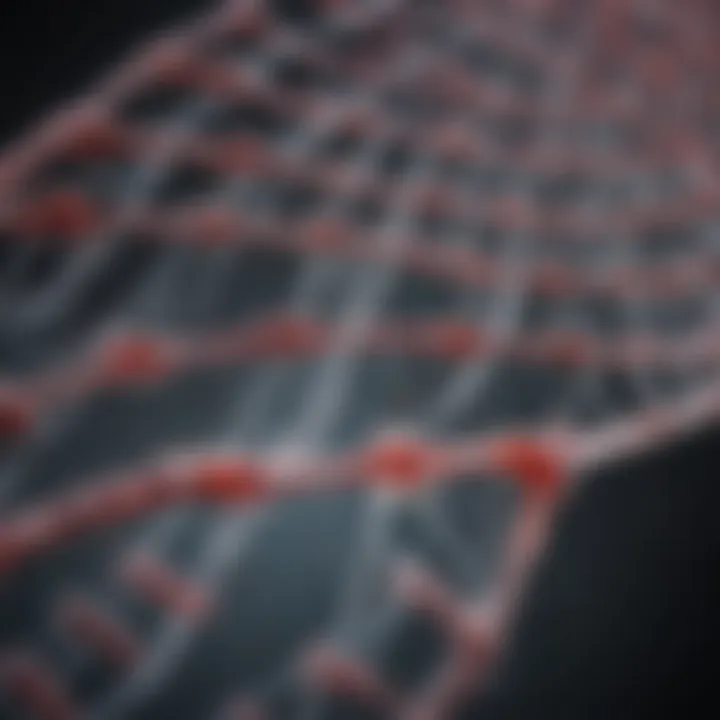cfDNA Screening: Transforming Genetic Testing


Intro
The advances in medical science have undoubtedly paved the way for techniques that offer deeper insights into our genetic makeup. Among these advancements, cell-free DNA (cfDNA) screening stands out as a remarkable innovation. With its ability to detect genetic abnormalities through a simple blood test, the method has captured the attention of healthcare professionals and researchers alike.
Circulating cell-free DNA refers to small fragments of DNA that float around in bodily fluids, primarily blood. These snippets can provide a wealth of information about various conditions, including genetic disorders and various forms of cancer. With minimal invasiveness, cfDNA screening allows doctors to gather valuable data without resorting to more painful or complex procedures.
To understand cfDNA more comprehensively, it's vital to delve into the context in which it operates. This method isn't just a trend; it marks a significant shift in how we approach genetics and personalized medicine. From prenatal care to oncology, cfDNA screening equips clinicians with tools to make informed decisions, leading to better patient outcomes.
As we embark on this exploration of cfDNA screening, it's essential to highlight not just its applications but also the ethical issues it raises. Privacy concerns, data security, and the implications of genetic testing need a thorough examination. By blending technological prowess with clinical insight, we can appreciate how cfDNA not only informs but also shapes the future of healthcare.
Prelude to cfDNA Screening
The realm of genetic screening has seen tides of transformation, especially with the advent of circulating cell-free DNA (cfDNA) screening. This method is more than just a trend; it's a step towards revolutionizing how we approach genetic testing. Understanding cfDNA screening is vital for students, researchers, and practitioners alike. It holds the promise of heightened accuracy in diagnostics while reducing the physical burden on patients.
Defining cfDNA
Circulating cell-free DNA is essentially fragments of DNA that are freely floating in the bloodstream. Unlike genomic DNA that resides within cells, cfDNA comes from apoptotic and necrotic cells that release their genetic material into the circulation. These floating pieces of DNA can be extracted from bodily fluids such as blood, offering a glimpse into the individual's genetic blueprint. Their analysis can reveal the presence of genetic abnormalities or disease without the need for invasive procedures, making it a game-changer in both prenatal screening and cancer diagnostics.
The focus on cfDNA allows for the detection of specific genetic markers and mutations that could indicate a variety of conditions. One might say that cfDNA acts as a tiny window into the biological functioning of the body, reflecting a myriad of information that can inform clinical decisions.
Historical Context
The journey of cfDNA screening began with humble origins in the late 20th century. Initially, researchers observed that DNA could be found circulating in serum and plasma, but its clinical implications were not immediately apparent. It wasn't until the early 2000s that advancements in technology, particularly PCR (polymerase chain reaction) and next-generation sequencing techniques, began to highlight cfDNA's potential.
As more studies emerged, the awareness of cfDNA evolved from a laboratory curiosity to a critical player in the genetic testing landscape. The introduction of non-invasive prenatal testing (NIPT) in the early 2010s marked a turning point, making headlines with its ability to detect chromosomal abnormalities in fetuses with a simple maternal blood draw. This was a watershed moment that spurred further interest and investment into cfDNA research, leading to its application in oncology and other fields.
Today, the integration of cfDNA screening into clinical practice reflects years of scientific inquiry and innovation. It’s a testament to human ingenuity and the relentless quest for better health solutions, paving the way for more personalized and timely medical interventions.
Mechanisms of cfDNA Release
Understanding the mechanisms that lead to the release of circulating cell-free DNA (cfDNA) is crucial for interpreting its role in genetic diagnostics and prenatal testing. This section dives into two primary processes responsible for cfDNA release: apoptosis and necrosis, along with active secretion methods. These mechanisms not only enhance our grasp of cfDNA dynamics but also spotlight the relevance of cfDNA in clinical applications. The myriad of factors influencing the levels and characteristics of cfDNA can inform treatment options and prognostic assessments in various medical settings.
Apoptosis and Necrosis
Apoptosis and necrosis represent two fundamentally different pathways of cell death, each contributing distinctively to the release of cfDNA.
Distinction between cell death types
The distinction between apoptosis and necrosis is often not just academic; it has practical implications in the context of cfDNA screening. Apoptosis is a programmed and highly regulated process of cell death that usually leads to cell shrinkage, chromatin condensation, and the formation of apoptotic bodies. This tidy method of cellular disposal ensures that the surrounding tissues are largely unaffected. On the other hand, necrosis signifies uncontrolled cell death that often follows severe stress or injury, leading to cell swelling and rupture, which can result in inflammation.
This distinction is significant when assessing cfDNA’s presence in various bodily fluids. The key characteristic that makes understanding this distinction valuable is how, in apoptosis, cfDNA is released in a more predictable manner. This predictability can aid in developing targeted therapies and screening processes. While both forms of cell death contribute to cfDNA levels, the clean release seen in apoptosis leads to fewer complications and a better understanding of the nucleic acids involved.
Mechanisms facilitating cfDNA release
The mechanisms that facilitate cfDNA release vary between these two forms of cell death. In the realm of apoptosis, the release of cfDNA is performed via a combination of cellular processes that are neatly orchestrated. This includes
- Caspase activation - enzymes that play a crucial role in the apoptotic pathway.
- Membrane blebbing - which allows cfDNA to be encapsulated in apoptotic bodies, preserving the integrity of the genetic material.
Conversely, in necrosis, cfDNA release can be more chaotic, stemming from cellular damage. The primary mechanism at play here includes:
- Cell lysis - which can lead to the spilling of cellular contents, including cfDNA, into the bloodstream, often resulting in a mixed population of cfDNA fragments.
While both pathways contribute to cfDNA pools, their differences raise questions regarding the quality of the cfDNA derived from each process. Apoptotic cfDNA tends to represent a more viable snapshot of the genomic status at the time of cell death, whereas necrotic cfDNA can introduce noise and ambiguity into results, complicating interpretation.
Active Secretion Processes
Recent studies suggest that cfDNA may also be released through active processes, not just as a byproduct of cell death.
Cells may actively secrete cfDNA into the bloodstream, a process made possible by exosome release and vesicular transport. These processes present a dynamic mechanism by which genetic information can be dispersed throughout the body without the cell itself dying. For instance,
- Exosomes can encase cfDNA, protecting it from degradation and facilitating its transfer to adjacent cells, thereby playing a role in intercellular communication.
- Nucleosomes, complexed with proteins, can also be secreted under certain stress conditions, providing another route for cfDNA dissemination.
The unique feature of these active processes is their implication for real-time monitoring of a patient’s genetic makeup.
In summary, the mechanisms of cfDNA release—including apoptosis, necrosis, and active secretion—highlight the multifaceted roles cfDNA can play in diagnostics and monitoring health. As research continues, uncovering the nuances of these processes can better inform clinical practices and improve patient outcomes.


Technological Advances in cfDNA Analysis
The rise of cfDNA screening technology has reshaped the way genetic information is gathered and interpreted in the medical field. This section dives into the significant technological strides made in the realm of cfDNA analysis, underscoring its integral role in the broader context of this emerging health frontier. Understanding these advancements is essential as they enhance the accuracy, reliability, and breadth of applications for cfDNA.
Next-Generation Sequencing
Overview of sequencing technologies
Next-generation sequencing (NGS) has emerged as a cornerstone in the examination of cfDNA. At its core, NGS enables researchers to read millions of DNA strands simultaneously, providing a monumental leap in both speed and volume of data obtained. Its key characteristic lies in the ability to produce extensive datasets with remarkable precision, making it a favored method in cfDNA analysis.
One principal reason for the popularity of NGS is its adaptability. Researchers can utilize it across a variety of applications, not limited to cfDNA but extending into whole genome sequencing and transcriptome studies. A unique feature of NGS is its high parallelization; multiple samples can be sequenced together, leading to a decrease in costs per sample and time, which stands in stark contrast to traditional sequencing methods. However, it does come with a disadvantage: managing and interpreting the massive amount of data generated can strain computational resources and expertise.
Applications in cfDNA analysis
The applications of NGS in cfDNA analysis are extensive, shaping the future of diagnostics and precision medicine. For instance, NGS allows for the detection of genetic mutations in various cancers by analyzing the circulating tumor DNA, which can be extracted from blood samples. This is particularly significant as it enables the identification of mutations without resorting to invasive procedures like biopsies.
A highlight of its utility is the tracking of tumor evolution over time, which offers critical insights into cancer progression or response to therapy. A unique aspect here is the real-time monitoring capability that NGS provides—allowing oncologists to adjust treatment protocols based on emerging resistance patterns of tumors.
However, it's worth noting that the sheer volume of data can sometimes lead to information overload. This can create challenges in drawing concise conclusions or actionable insights from the results, necessitating advanced bioinformatics capabilities to make sense of the findings.
Bioinformatics Tools
Data interpretation challenges
Biological data derived from cfDNA analyses can be a double-edged sword. While it provides a wealth of information, data interpretation can be riddled with challenges. The complexity and vastness of genomic data present significant hurdles, particularly when it comes to distinguishing clinically relevant findings from noise.
A notable characteristic of this challenge lies in the variant calling process where not all detected alterations have clinical significance. This aspect makes bioinformatics a critical player in processing and contextualizing results. The need for robust analytical frameworks is paramount, as researchers must discern which mutations warrant clinical attention while accounting for those that may be benign or inconsequential.
The potential pitfall is if the thresholds for reporting findings are set too low, it may lead to an avalanche of false positives, ultimately complicating patient management. Hence, this balance of sensitivity and specificity in data interpretation is vital for patient safety and the efficacy of cfDNA screening.
Emerging software solutions
In response to the complexities encountered in analyzing cfDNA data, the field has witnessed the development of innovative bioinformatics tools tailored to enhance data interpretation. These software solutions aim at streamlining data processing—from sequencing to variant analysis—to facilitate informed clinical decisions.
One of the standout attributes of these emerging software solutions is their ability to incorporate machine learning algorithms, enhancing the accuracy of variant classification. These technologies not only help in managing large datasets but also improve the understanding of genetic information through refined analytic approaches.
Nevertheless, the adoption of these tools can be contingent on user familiarity with computational biology. Some practitioners may find themselves daunted by the requirements of these sophisticated systems, potentially creating a gap in utilization and realizing the full benefits of cfDNA analysis technologies.
Clinical Applications of cfDNA Screening
Circulating cell-free DNA (cfDNA) screening has carved out a crucial niche in modern medicine, bringing forth a versatile approach to understanding genetic information. Its clinical applications span from prenatal testing to cancer diagnostics, making cfDNA analysis a powerful tool for healthcare professionals. The non-invasive nature of cfDNA screening, coupled with its ability to provide timely results, offers significant advantages over traditional testing methods. Understanding these applications is vital as they directly impact patient care and treatment strategies.
Prenatal Testing
Prenatal testing has benefitted immensely from cfDNA screening, particularly in the early stages of pregnancy.
First-trimester screening advantages
The first-trimester screening represents a turning point in prenatal care. Unlike older methods, cfDNA can be analyzed as early as the tenth week of gestation. This capability allows for early detection of conditions like Down syndrome, which many parents find immensely reassuring. One key characteristic of first-trimester screening is its accuracy; studies show that it boasts a higher detection rate for aneuploidies compared to traditional methods. Additionally, because this method requires only a maternal blood sample, it reduces the physical strain commonly associated with invasive procedures like amniocentesis.
Consequently, the popularity of first-trimester screenings is on the rise. Parents are increasingly drawn to the idea of being informed early on, which adds an emotional layer to the medical benefits. One unique aspect lies in how it minimizes the anxiety that expectant couples often experience. However, while the advantages are clear, it’s worth noting that no screening is wholly foolproof—false positives can occur, which might lead to unnecessary stress.
Comparison with traditional methods
When comparing cfDNA screening to traditional prenatal testing methods, several distinctions arise. Traditional methods like nuchal translucency measurements combined with maternal serum markers have been the backbone of prenatal screening for years. However, these approaches can only be accurately performed in a limited window and often require multiple visits. In contrast, cfDNA screening simplifies the process, providing comprehensive results from a single test.
Moreover, traditional methods generally carry a risk of miscarriage due to their invasive nature, while cfDNA testing does not. This aspect makes cfDNA screening a more appealing option for many expectant parents. On the downside, traditional methods often provide immediate preliminary data, while cfDNA results can take longer. This delay can be a drawback for those anxious for answers, leading to criticism regarding the timeliness of cfDNA analysis. Nevertheless, the comparative efficiency and safety of cfDNA screening make it a popular selection for many professionals in the prenatal space.
Cancer Diagnostics
Cancer diagnostics sees its own revolutionary transformation with the advent of cfDNA technology. The ability to detect cancer-related mutations in circulating DNA opens doors for better treatment decisions and patient outcomes.
Detecting mutations and heterogeneity
Detecting mutations via cfDNA presents a contemporary promise in oncology. The analysis of cfDNA allows for a real-time glimpse into a tumor's genetic landscape, informing doctors of existing mutations that might be targetable. A distinct advantage here is that cfDNA provides insights into the heterogeneity of tumors. This characteristic is paramount, as tumors often exhibit a mix of genetic variations. Being aware of this variability aids oncologists in personalizing treatment plans, optimizing therapeutic strategies, and improving patient outcomes.
However, it’s crucial to note that while cfDNA can detect these mutations, it cannot determine their exact origin within the body. Thus, while valuable, this method should be integrated into a broader diagnostic framework. The complexity of interpreting heterogeneous results sometimes leads to confusion; health professionals must tread carefully to avoid premature conclusions based solely on cfDNA data.


Role in monitoring treatment response
Monitoring treatment response using cfDNA offers a non-invasive snapshot into how well a patient is adapting to therapy. Regularly analyzing cfDNA levels can indicate whether a treatment is working by revealing the presence or absence of tumor DNA in the bloodstream. This method provides immediate feedback, allowing for timely adjustments in treatment plans.
One of the significant benefits of using cfDNA in this way is the reduction of invasive biopsies, which are often painful and can carry risks. Moreover, the convenience of at-home blood collection encourages patient adherence to monitoring schedules. Despite these compelling benefits, challenges remain, particularly in ensuring that cfDNA analysis is accurately measuring what it claims. Variability in individual biology can lead to fluctuations in cfDNA levels, complicating the interpretation of results.
Advantages of cfDNA Screening
Circulating cell-free DNA screening has emerged as a transformative tool in modern medicine, providing several noteworthy benefits that make it stand out in both genetic testing and clinical evaluations. These advantages center around its non-invasiveness and the timeliness of results, presenting significant impacts on patient care and decision-making.
Non-Invasiveness
The fact that cfDNA screening can be performed using a simple blood sample signifies a major leap forward. This non-invasive approach is particularly advantageous for several reasons.
Patient comfort and reduced risk
Taking a blood sample is inherently less traumatic for patients compared to traditional procedures, like biopsies. A key characteristic of this method is the minimal discomfort experienced during the test. Patients usually feel a quick pinch at the needle site, but the overall experience can be much less daunting. This comfort factor encourages more individuals, especially those at higher risk for certain conditions, to opt for screening without the fear associated with invasive methods.
Additionally, since there are no risks tied to surgical complications or infection—a common concern with invasive biopsies—the appeal for cfDNA screening grows stronger. By promoting patient acceptance and compliance, the widespread use of this method could lead to earlier detection of genetic abnormalities or cancers, ultimately improving health outcomes.
Implications for patient adherence
The incorporation of cfDNA screening into healthcare routines brings forth vital implications for patient adherence. Due to its ease and comfort, patients are more likely to participate in regular screenings. This is particularly significant for populations that might otherwise shy away from traditional testing due to fear or discomfort.
Moreover, the convenience of a straightforward blood draw means that healthcare providers can offer quick and efficient testing without the lengthy preparation or recovery associated with more invasive procedures. Such features not only enhance patient experience but also foster a culture of proactive health management. If patients feel secure and understand the routine nature of the process, they are more likely to keep up with follow-up screenings, thereby making informed decisions regarding their health.
Timeliness of Results
Another outstanding advantage of cfDNA screening lies in its quick turnaround time for results. In healthcare, time can be the difference between life and death, making timely information critical for patient care. With cfDNA analysis, results can become available in a matter of days rather than weeks. This swiftness facilitates timely interventions, allowing clinicians to act swiftly when dealing with concerning test results.
The rapid feedback loop contributes significantly to better patient management strategies and response plans, particularly in oncology where time-sensitive treatment decisions are paramount. The sooner a patient receives their results, the sooner they can be counseled on potential next steps, whether that involves further testing, monitoring, or even immediate treatment.
Thus, the advantages of cfDNA screening underscore its importance in the landscape of medical advancements, bridging the gap between traditional testing methods and modern healthcare needs. These traits make cfDNA screening not only a patient-friendly option but also a crucial element in advancing personalized medical care.
Limitations and Challenges
In the realm of cfDNA screening, understanding the limitations and challenges is crucial for a balanced discussion of its capabilities and potential drawbacks. While this innovative technique offers promising advancements in genetic testing, its implementation is not without hurdles. These challenges can affect its reliability, regulatory acceptance, and ultimately its integration in clinical practices.
Sensitivity and Specificity
Sensitivity and specificity are cornerstones of any diagnostic test, and they play a significant role in the effectiveness of cfDNA screening. Sensitivity refers to the test's ability to correctly identify those with a particular condition, whereas specificity relates to its capacity to correctly identify those without the condition.
False positives and negatives
False positives and negatives can create significant issues when interpreting cfDNA screening results. A false positive implies the test indicates abnormalities that are not actually present, which can lead to unnecessary stress and potentially invasive follow-up procedures. In contrast, a false negative results in missing an actual condition, potentially allowing a disease to progress unnoticed.
The challenge here lies in the precision of the analyzation methods and biological variability. False positives, while problematic, can sometimes be prevented by using multiple test criteria or repeat testing, but they often still exist due to technical limitations. Understanding these risks is essential for healthcare providers to convey accurate information to patients, ensuring they grasp the significance—and limitations—of their results.
Factors influencing accuracy
Several factors influence the accuracy of cfDNA tests, making its reliability complex. For instance, the concentration of cfDNA can vary based on the individual's age, health status, and the timing relative to certain medical procedures. Each of these can alter results, leading to variations in test outcomes. The challenge is in normalizing these variables, which is important for establishing protocols that produce consistent results across diverse populations. Strategies such as standardized sample collection and processing are being explored, but these solutions are still in development, highlighting the ongoing need for addressing this issue as the technology advances.
Regulatory Concerns
As the clinical usage of cfDNA screening expands, regulatory concerns remain a top priority. Ensuring that these tests meet established safety and efficacy standards is vital for public trust and utilization.
Need for standardization
Standardization in cfDNA screening is of paramount importance. A lack of uniform guidelines can result in discrepancies across laboratories, leading to confusion and mistrust among patients and professionals alike. Standardization helps ensure consistent protocols for sample collection, testing, and analysis, leading to more reliable results across the board. Furthermore, standardized methods can facilitate clearer communication between professionals, ensuring everyone involved interprets results based on the same framework. Therefore, achieving an industry-wide consensus on protocols can ultimately enhance the credibility of cfDNA screening as a diagnostic tool.
Approvals from health authorities
Gaining approvals from health authorities is another challenge faced by cfDNA screening technologies. Each regulatory body has its own set of requirements that can vary significantly from one jurisdiction to another. This patchwork of regulations can slow down the introduction of new tests and technologies into clinical practice. Additionally, obtaining these approvals requires rigorous validation studies that demonstrate the tests’ effectiveness and accuracy. This process can be lengthy and complex, potentially delaying patient access to these valuable diagnostic tools. Thus, navigating the regulatory landscape is essential for developers of cfDNA screening technologies to ensure that innovations can reach clinical settings swiftly and safely.
Ethical Considerations
The advent of circulating cell-free DNA (cfDNA) screening carries with it a plethora of ethical considerations that must be navigated with care. Genetic testing technologies can illuminate potential health risks, providing crucial information that can guide clinical decisions. However, this power comes intertwined with responsibilities that question the very fabric of patient autonomy, privacy, and societal implications.


In this article, we delve into specific elements surrounding ethical aspects, notably informed consent and privacy concerns. The balance between gaining knowledge and respecting individual rights is a delicate dance that healthcare providers must perfect. Understanding these issues is integral to nurturing trust in modern medical practices that utilize cfDNA technologies, ensuring that the advancements in this field do not outpace our ethical frameworks.
Informed Consent
Informed consent is the bedrock of ethical medical practice, particularly in genetic screening. It empowers patients with the right to understand, deliberate, and decide whether to undergo testing. This clearly delineates their autonomy in deciding what happens to their genetic information.
When it comes to cfDNA screening, it is paramount that individuals are not only making informed decisions based on comprehensive information, but also have a full grasp of potential outcomes. It’s one thing to provide a patient with a consent form; it’s another to ensure they fully contemplate the implications of the results. Before opting in, individuals should be briefed about everything, from what cfDNA can reveal to the possible emotional toll of unexpected results.
Privacy and Data Security
Privacy practices surrounding cfDNA screening are crucial. The data extracted in these tests can provide insights into not just an individual’s health but also their familial lineage. Safeguarding this information from unauthorized access is essential.
Storage of Genetic Data
When discussing the storage of genetic data, the focus lies on how securely the information is kept. Using advanced encryption methods and well-secured databases is vital to ensure that sensitive genetic information remains confidential. The key characteristic of effective storage solutions is their ability to offer easy access for authorized personnel while thwarting attempts by malicious actors. However, despite advancements, there are still qualms about long-term storage viability and loss of data integrity over time.
Unique features of genetic data storage systems often include cloud services that promise quick recovery and backup. Yet, debates continue over the pros and cons. Advantages may involve significant investment in security, while disadvantages can arise in the form of high costs and potential vulnerabilities to cyber-attacks.
Concerns over Data Breaches
There is no denying that concerns surrounding data breaches loom large in this sphere. Every time patient information is accessed without consent, it raises alarms. The key characteristic here is not just the possibility of unauthorized access but the potential ramifications that such events entail. For instance, should sensitive health data fall into the wrong hands, it may lead to discrimination or stigmatization.
Understanding the gravity of these concerns is essential. Institutions handling cfDNA data must adhere strictly to regulations like HIPAA (Health Insurance Portability and Accountability Act) to mitigate risks. A unique feature of current strategies involves implementing comprehensive monitoring solutions to flag breaches in real-time, thus allowing quick responses.
In this regard, the advantages are nothing to scoff at: awareness and preparedness can significantly reduce the fallout from potential breaches. On the other hand, the disadvantages include the constant need for updates and awareness in a rapidly evolving technological landscape.
The road ahead for cfDNA screening is not just one of scientific advancement, but also a path paved with ethical responsibilities that must be taken seriously.
Future Perspectives
The future of cfDNA screening holds immense promise for reshaping the landscape of genetic analysis. As technology progresses and a deeper understanding of molecular biology unfolds, we stand at the brink of integrating cfDNA screening more robustly into clinical practice. The emphasis on routine application of cfDNA testing opens new avenues for early detection and monitoring of diseases, transforming preventive healthcare strategies.
Integration into Routine Practice
Integrating cfDNA testing into everyday medical protocols can have significant implications for patient care. Currently, adoption in mainstream medical practice varies, but several studies show that incorporating cfDNA analyses can lead to timely interventions. The benefits of early disease detection are manifold, particularly in areas like oncology and prenatal testing.
Physicians are already starting to consider cfDNA tests as a first-line option rather than a follow-up after more invasive procedures. The advantages here are clear: better patient comfort, reduced psychological burden, and potentially lower healthcare costs due to decreased reliance on invasive techniques like biopsies. For it to become routine, continued education and training for healthcare professionals is critical, ensuring they're equipped to interpret results accurately and convey that information to patients effectively.
Ongoing Research Areas
Research in cfDNA screening is rapidly expanding, with several key areas receiving attention that promise to enhance our understanding and utilization of this technology.
Expanding Applications
As researchers dive deeper into the potential of cfDNA, the new applications being explored range sharply. One of the most compelling aspects is the potential for cfDNA analyses in various clinical settings beyond prenatal and cancer diagnostics. For instance, studies are emerging on cfDNA's role in managing cardiovascular diseases and even in monitoring organ transplant rejection.
The benefit lies in the ability to detect conditions early and with minimal invasiveness, making them appealing for patient populations who might be reluctant to undergo more invasive procedures. However, one must remain cautious, for the disadvantage is that understanding the wide-ranging implications of these tests can take time, necessitating thorough investigations and trials before they safely enter routine clinical use.
Technological Innovations
Technological advancements in sequencing and bioinformatics are vastly improving cfDNA screening's accuracy and efficiency. Cutting-edge methods like digital droplet PCR (ddPCR) and novel sequencing platforms are enhancing sensitivity, enabling researchers to detect rare mutations that traditional methods might miss.
The key characteristic of these innovations is their ability to provide high throughput, delivering results that are not just timely but also actionable. Moreover, advanced algorithms and machine learning applications are paving the way for improved data interpretation, making trends and patterns in cfDNA profiles far more accessible.
- Advantages: This technological leap can streamline healthcare workflows, reduce costs associated with lengthy tests, and therefore improve patient outcomes.
- Disadvantages: It is pivotal to consider the potential drawbacks too, such as the high costs associated with cutting-edge technology and the requirement for continuous updates and maintenance, which may be a hurdle for some healthcare facilities.
"The evolution of cfDNA screening is poised to redefine the relationship between genetic information and patient care, suggesting a movement towards increasingly personalized healthcare solutions."
As we anticipate these advancements, the focus should remain on ethical considerations and regulatory frameworks that ensure patient safety and data security, preparing the groundwork for a future where cfDNA screening is not just an option but a standard in healthcare diagnostics.
Closure
In wrapping up our exploration into cfDNA screening, it is paramount to underscore the significance of this method in the healthcare arena. As we’ve seen, cfDNA screening not only represents a leap in technology but also aligns closely with the evolving demands of modern medicine, particularly in prenatal and oncology settings.
The ability to analyze circulating cell-free DNA enables practitioners to pinpoint genetic abnormalities accurately with minimal discomfort to the patient. The relevance of this method is amplified when considering the non-invasive nature of the tests, which has been a game-changer for prenatal screening. Women in earlier stages of pregnancy now have access to crucial genetic information that can influence their health decisions, shifting the paradigm from reactive to proactive care.
Moreover, in the realm of cancer diagnostics, cfDNA screening acts akin to a magnifying glass, revealing details about tumor heterogeneity and mutations that were previously challenging to detect through traditional biopsy methods. This potential to provide timely, actionable insights facilitates better monitoring of treatment responses and can significantly impact patient outcomes.
However, as we venture further down this path, it is vital to remain cognizant of the ethical concerns that accompany this technology. Issues surrounding informed consent, data privacy, and the handling of sensitive genetic information pose challenges that must be navigated cautiously. Regulations must be in place to ensure that innovations do not outpace governance, guaranteeing that individuals' rights and data are protected.
The future of cfDNA screening is bright, but it will thrive only if we are equipped to address these ethical dilemmas head-on while continuing our commitment to enhancing patient care. Ultimately, cfDNA screening embodies the ideal of personalized medicine, tailoring interventions based on genetic profiling, which holds the promise of enhanced therapeutic effectiveness and better healthcare delivery.
As the field progresses, staying informed about ongoing research areas and embracing technological innovations will be essential to fully realize the potential of cfDNA in transforming healthcare. The implications of this screening are far-reaching, and their benefits will likely resonate throughout generations, making it a cornerstone of modern diagnostic approaches.



